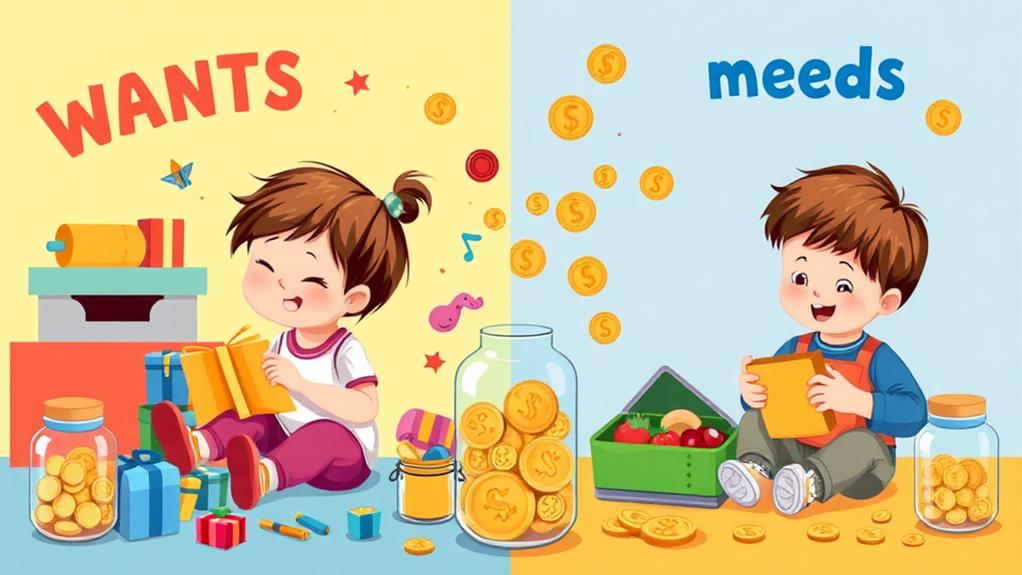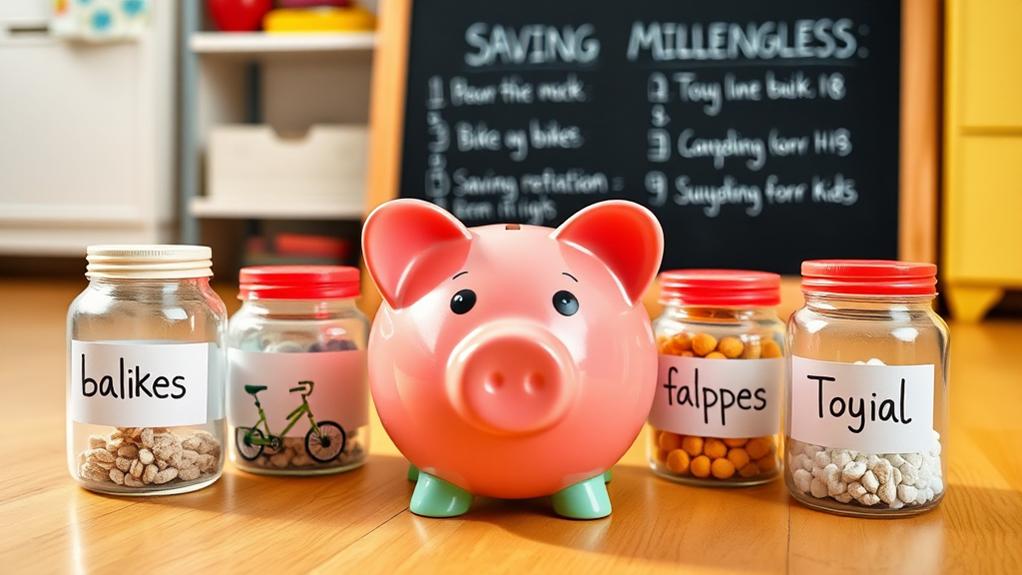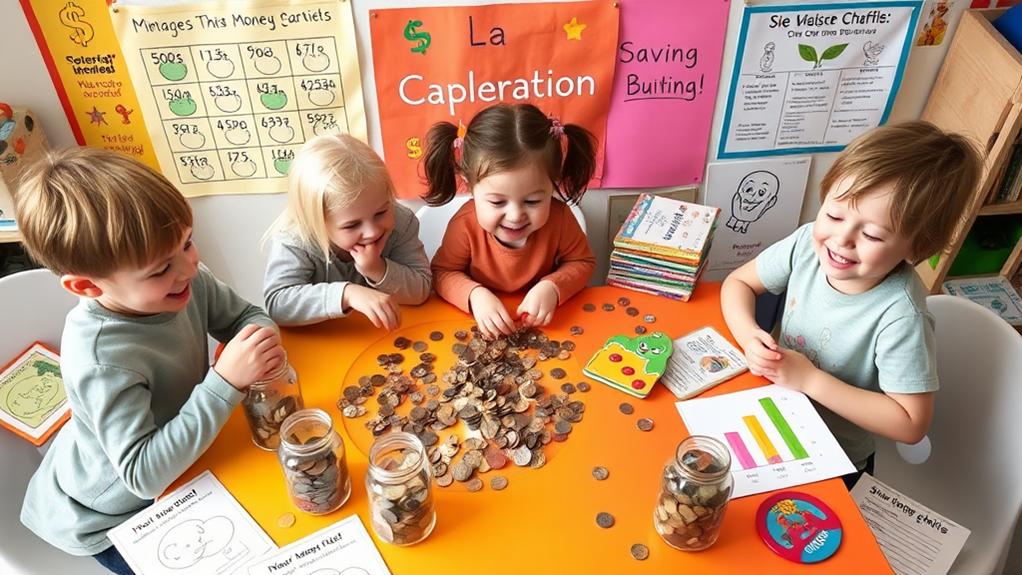10 Money Saving Tips for Kids to Teach Early
Teaching kids to save money early can set them on the path to financial success. Start by helping them understand the difference between wants and needs. Use allowances to teach budgeting—encourage them to save a portion for later. Setting clear savings goals makes managing money feel achievable. Use fun tools like piggy banks or kid-friendly apps to track their savings. Allowing mistakes offers valuable lessons, while incentives for reaching goals can motivate them. Consistent discussions about money habits are essential for lasting understanding. Explore the tips that can help build a solid financial foundation for your children.
Key Takeaways
- Teach kids the difference between wants and needs to help them prioritize their spending effectively.
- Encourage saving a portion of their allowance for future goals, promoting delayed gratification.
- Use visual tools like piggy banks or savings jars to track progress toward savings milestones.
- Involve kids in family budgeting discussions to foster understanding and responsibility in financial decisions.
- Implement a savings match program to illustrate the benefits of compounded growth and incentivize saving.
Discuss Wants vs. Needs

Have you ever stopped to think about what you really need versus what you just want? Understanding the difference between wants and needs is vital for your financial education. Needs, like food and clothing, are essentials, while wants, like toys or games, are nice but not necessary. Teaching kids this distinction helps develop good saving habits and fosters financial responsibility.
Engaging in discussions about specific items can help kids prioritize spending. For example, when comparing grocery expenses (needs) to entertainment costs (wants), they can see how to allocate their money wisely. Encourage them to list their desires and categorize them as needs or wants. This exercise enhances critical thinking and sharpens decision-making skills, allowing them to set realistic savings goals.
Allowances and Earning Money

Understanding how allowances work and the importance of earning money can be a game-changer in your child's financial education. In fact, 75% of parents provided allowances in 2022, averaging about $19.39 weekly. Allowances give kids a practical tool to learn budgeting skills by dividing their money into spending, saving, and sharing.
Earning money through chores not only cultivates a strong work ethic but also teaches your child the value of responsibility in managing finances. When they have to make choices between spending and saving their allowance, it reinforces vital financial decision-making skills. You can encourage them to prioritize their financial goals, whether that's saving for a toy or a game.
Teaching your child to save a portion of their allowance helps instill the concept of delayed gratification and financial planning. As they see their savings grow, they'll learn that money management is not just about immediate gratification but also about working towards something bigger. With these lessons, your child can build a solid foundation for a financially responsible future.
Setting Savings Goals

Setting savings goals is essential for teaching kids the value of money and fostering a sense of responsibility. By setting clear and specific goals, you can help your child understand the importance of delayed gratification. For instance, saving for a $50 video game can motivate them to stick to their savings plan.
To make savings feel more achievable, break larger goals into smaller milestones. For example, saving $5 each week can keep them committed. Tracking progress is vital—use visual tools like charts or jars to show how savings accumulate over time.
Here's a simple example to illustrate:
| Savings Goal | Weekly Savings | Time to Reach Goal |
|---|---|---|
| Video Game ($50) | $5 | 10 weeks |
| New Toy ($20) | $2 | 10 weeks |
| Book ($15) | $3 | 5 weeks |
To further motivate your child, consider offering incentives, like matching a percentage of their savings. This can reinforce positive saving behaviors and enhance their financial habits. Encouraging realistic goals will also teach them valuable budgeting skills.
Practical Tools for Saving

Once your child has established their savings goals, the next step is to equip them with practical tools that make saving easier and more engaging. For younger kids, a piggy bank or savings jar is perfect for visually tracking their progress. Watching money accumulate over time can be exciting and reinforces the concept of saving money.
As children grow, consider introducing them to kid-friendly debit cards, like FamZoo or Greenlight. These tools help teach children essential financial management skills in a controlled environment. You can also use jars or envelopes for different purposes—spending, saving, and sharing. This method teaches them to allocate money effectively, giving them a clearer understanding of their financial goals.
Encouraging regular deposits into their chosen savings tool reinforces the habit of saving. To boost motivation, create a visual representation of their savings progress, such as a chart or graph. This not only shows the impact of their efforts but also makes the journey toward their savings goals more tangible and rewarding. By using these practical tools, you're setting your child up for success in developing lifelong financial skills.
Learning Through Mistakes

Financial mistakes can feel intimidating, but they're often the best teachers when it comes to money management. Allowing children to make financial decisions—even if it means overspending their allowance—can provide valuable lessons about the consequences of their choices. These experiences foster resilience and encourage kids to develop essential money habits.
Research shows that when children encounter mistakes in budgeting or saving, it creates teachable moments. You can help them understand the importance of planning and prioritizing their financial goals. By discussing errors openly, you guide them in analyzing what went wrong and how to avoid similar pitfalls in the future, reinforcing their sense of accountability.
Teaching kids the value of responsibility in managing their finances promotes independence and builds confidence as they grow older. As they learn about saving for college or other aspirations, these early mistakes can lay the groundwork for strong financial literacy. Remember, the path to smart money management isn't always smooth, but each misstep is a stepping stone toward becoming a savvy spender. Embrace those moments, and watch your children flourish in their understanding of money.
Engaging Kids in Money Concepts

Engaging kids in money concepts can be both fun and educational, and there are many creative ways to do it. One powerful method is incorporating storytelling and real-life examples to teach financial principles. This makes the concepts relatable and easier for kids to grasp. You can also utilize technology by introducing financial apps designed for kids, creating interactive experiences that help them learn about saving, budgeting, and spending.
Encouraging participation in family budgeting discussions fosters a sense of responsibility. When kids learn to understand expenses and plan, they become more financially savvy. Normalize money conversations within your household to reduce any embarrassment, making it easier for children to ask questions and expand their understanding of financial concepts.
Additionally, consider creating fun games or competitions around financial planning. This not only makes learning enjoyable but also helps kids learn essential skills in a memorable way. By engaging your child in these activities, you're not just teaching them about money as a kid; you're equipping them with lifelong knowledge that will serve them well in the future.
Incentives for Saving

As kids become more familiar with money concepts, it's important to introduce them to the idea of saving through various incentives. You can help kids save money by offering a savings match—like matching 50% of what they save. This teaches them about the value of compounded growth early on.
Setting up a reward system for reaching savings milestones is another effective way to encourage them. When they hit specific targets, they could earn bonuses that reinforce positive financial habits. You might also create fun competitions among siblings or friends, like who can save the most in a month, to make saving more engaging and foster a sense of achievement.
Highlighting tangible rewards, such as a special outing or a small gift for reaching a savings goal, can further motivate your kids to prioritize saving over spending. Discussing the benefits of saving, like purchasing something they truly want or contributing to a future goal, reinforces the idea that saving leads to greater financial freedom and satisfaction. By teaching these habits, you're setting your kids on the path to financial success and a brighter financial future.
Importance of Consistency

Establishing consistency in discussions about money is essential for helping kids develop strong financial habits. By engaging in regular conversations about finances, you can teach your children the importance of money management and instill positive money habits that will serve them well throughout their lives. Consistent discussions help kids feel more comfortable and confident as they learn to save and make informed decisions.
To create a routine for financial discussions, consider the following:
- Set up weekly family meetings to discuss budgeting and saving techniques.
- Encourage kids to track their expenditures and savings regularly.
- Share real-life financial scenarios to foster understanding and engagement.
- Celebrate milestones, like reaching savings goals, to reinforce positive behavior.
Research shows that children who experience ongoing financial education are better equipped to handle financial challenges. By establishing a routine for these discussions, you'll help your kids internalize money management concepts and develop habits that will serve them well as they grow. Remember, consistent engagement is key to building a strong foundation for their financial future.
Financial Literacy for Success

While many people think of financial literacy as a complex subject reserved for adults, it's actually an essential skill that kids can—and should—start learning early. By teaching children about money management, you lay the groundwork for their independence and accountability in financial matters. Research shows that habits formed in childhood persist into young adulthood, making early education vital for lifelong success.
Engaging your kids in conversations about financial concepts normalizes money discussions. This not only fosters a deeper understanding of money but also helps them set savings goals. When children grasp the importance of budgeting and saving, they're better equipped to become responsible consumers and make informed decisions as they grow.
Encouraging your children to practice financial literacy can greatly reduce future financial challenges. By instilling these skills now, you empower them to navigate their financial lives confidently. Remember, a strong foundation in financial literacy isn't just about avoiding debt; it's about building wealth and security. Equip your kids with the tools they need for a prosperous future, and watch them thrive as financially savvy individuals.
Resources for Financial Education

When it comes to financial education for kids, a wealth of resources is available to help them grasp essential money management skills. You can empower your children with knowledge and tools that make learning about financial literacy fun and engaging. Here are some valuable resources to contemplate:
- Financial education apps like Greenlight or FamZoo, which let kids manage savings and spending while learning concepts in a playful way.
- Engaging financial literacy books such as "Money Ninja" by Mary Nhin or "The Everything Kids' Money Book" by Brette Sember, providing relatable lessons on saving and budgeting.
- Community programs and workshops focused on financial literacy, offering resources and tools for teaching children about money management.
- Online courses or webinars that feature interactive lessons on critical topics like saving, spending, and investing.
Additionally, organizations like the Jump$tart Coalition and the National Endowment for Financial Education provide curricula and materials designed to promote financial literacy among young learners. By utilizing these resources, you'll equip your kids with the knowledge they need to make informed financial decisions now and in the future.







